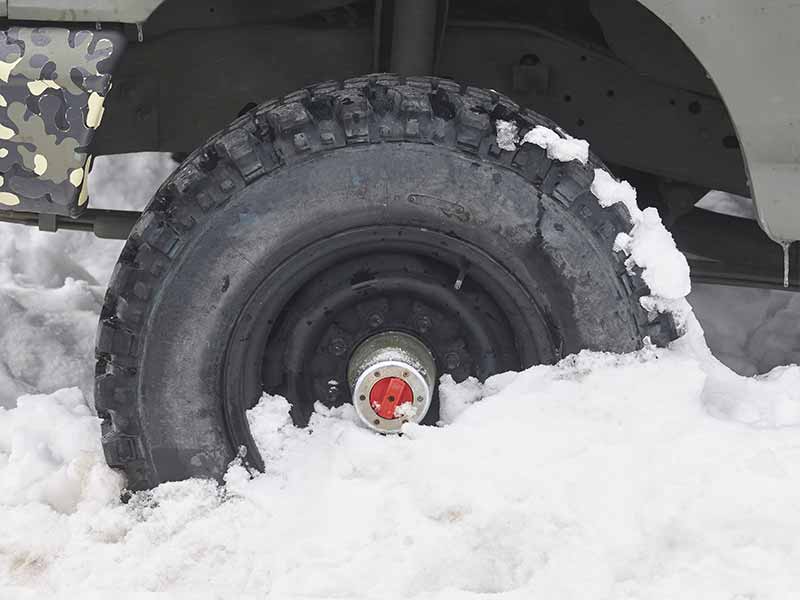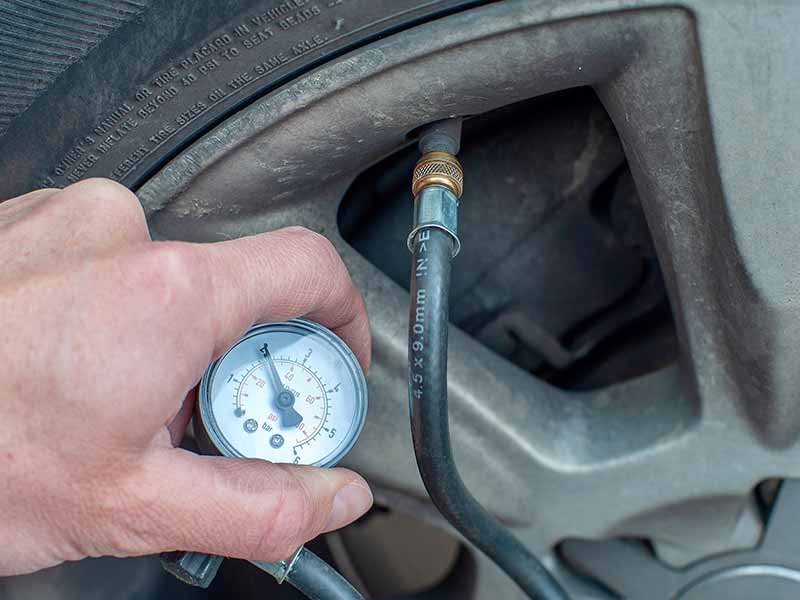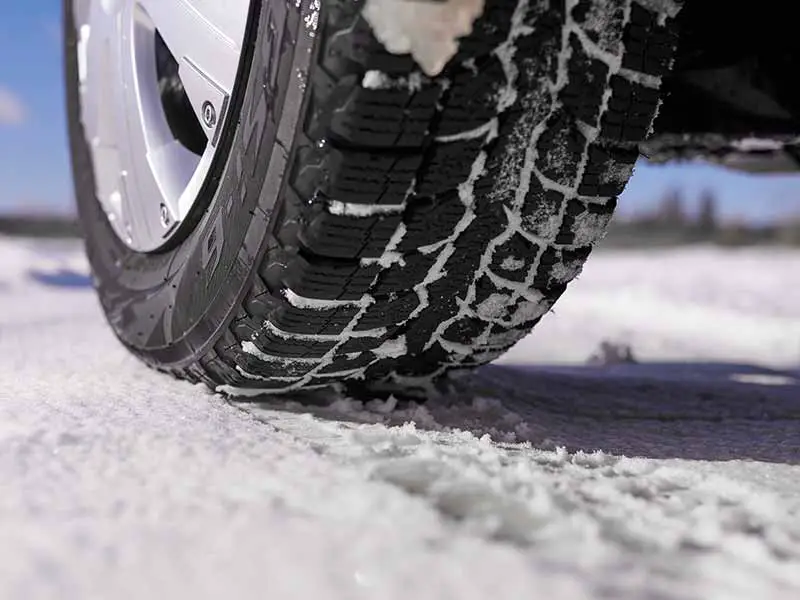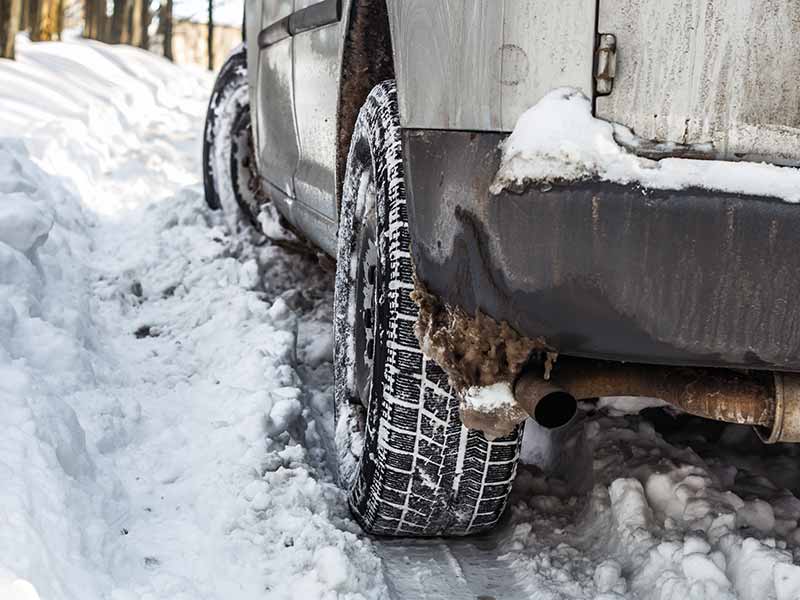Are you ready to conquer the snowy roads ahead? Understanding the nuances of tire pressure in deep snow is crucial for any driver braving the winter’s challenges. Whether you’re navigating a light flurry or a heavy blizzard, knowing how to optimize your tire pressure can mean the difference between a slippery situation and a stable journey.
Tire Pressure For Deep Snow
For optimal traction in deep snow, it’s generally recommended to slightly reduce your tire pressure from the normal setting by 3 to 5 psi.
This adjustment increases the tire’s contact area with the snow, improving grip and stability.
In this article, we’ll explore the science behind tire pressure, its impact on traction in deep snow, and how to adjust it for different types of vehicles. You’ll find detailed guides, safety considerations, and maintenance tips to ensure your journey is as safe as it is smooth.

The Science Behind Tire Pressure
When we talk about tire pressure, we’re referring to the amount of air inside your tires, a critical factor in how your vehicle handles and performs, especially in challenging conditions like deep snow. Measured in pounds per square inch (PSI), tire pressure is not just a number but a baseline for safety, efficiency, and, yes, comfort on the road.
- Why It Matters: Proper tire pressure is crucial for optimal vehicle handling, fuel efficiency, and tire longevity. Too high or too low, and you’re looking at compromised performance and safety.
- Units of Measurement: Typically, we measure tire pressure in PSI, though other units like bar or kPa are also used globally.
Impact on Vehicle Performance
- Traction Control: Correct tire pressure ensures the maximum amount of tire is in contact with the road, providing better grip, especially in slippery conditions like snow.
- Fuel Efficiency: Believe it or not, the right tire pressure can also help your vehicle run more efficiently, saving you money at the pump.
- Wear and Tear: Consistent, correct tire pressure helps your tires wear evenly, extending their life and performance.
While tire pressure is a small part of vehicle maintenance, its impact is huge. As you prepare to navigate the snowy roads, understanding the basics of tire pressure sets you up for a safer, smoother ride. For a deep dive into how much you should air down your tires for snow, explore our comprehensive guide on adjusting tire pressure for snowy conditions.

The Role of Tire Pressure in Deep Snow Traction
As you venture into deep snow, understanding the relationship between tire pressure and traction becomes more than just mechanical knowledge—it’s your key to safer and more effective driving. Let’s break down how tire pressure directly influences your traction in snowy conditions.
Traction and Tire Footprint
- Contact Area: The portion of your tire that touches the ground is known as the footprint. Proper tire pressure ensures an optimal footprint, maximizing the tire’s ability to grip the road.
- Snowy Surfaces: In deep snow, the goal is to increase the tire’s contact area with the ground to distribute the vehicle’s weight more effectively and gain better traction.
Balancing Act: Pressure, Traction, and Efficiency
- Finding the Sweet Spot: It’s about finding the right balance. Too low tire pressure might increase traction but can lead to tire damage and reduced fuel efficiency. Conversely, too high tire pressure reduces the footprint, diminishing traction.
- Professional Insight: Adjusting tire pressure for deep snow isn’t a one-size-fits-all solution. It depends on your vehicle type, tire specifications, and the snow’s depth and consistency.
As you adjust your tire pressure for better traction in deep snow, remember that it’s a delicate balance.
You want enough grip to control your vehicle effectively but not so much that you’re compromising tire integrity or fuel efficiency.
For more detailed information on how to adjust your tire pressure for off-road conditions, including deep snow, check out our dedicated resource on airing down tires for off-road adventures.

Optimal Tire Pressure for Deep Snow
Venturing into deep snow means adapting to the environment, and a critical part of that adaptation is setting your tire pressure for optimal traction. Let’s get into the specifics of what tire pressure ranges are recommended for deep snow conditions, focusing on both passenger cars and trucks.
For Passenger Cars
- General Recommendation: Typically, a slight reduction in tire pressure from the manufacturer’s recommendation is beneficial in deep snow. This increases the tire’s contact area, improving grip.
- The Range: While the exact pressure can vary depending on tire and vehicle type, a reduction of about 3-5 PSI from normal conditions is a common starting point. Always stay within the safety limits specified by your tire and vehicle manufacturer.
For Trucks
- Heavier Loads, Different Needs: Trucks, especially those carrying heavier loads, might need a different approach. The right pressure can significantly affect handling and traction under these conditions.
- The Range: Similar to passenger cars, a slight decrease can aid in traction. However, due to the heavier weight, the decrease may be less, usually around 2-4 PSI. Again, the key is never to exceed the minimum recommended pressure for safety and performance.
Important Considerations
- Front vs. Rear Tires: Some vehicles may require a different pressure in the front and rear tires, especially trucks with different load distributions.
- Temperature Effects: Remember, tire pressure decreases in cold weather. Check and adjust accordingly, especially when transitioning between heated garages and the outdoors.
Setting the right tire pressure for deep snow is more than a mere number; it’s about understanding your vehicle’s needs and how it interacts with the snowy terrain.
For those interested in the intricacies of adjusting tire pressure and the tools involved, especially when you don’t have beadlocks, our article on airing down without beadlocks offers a detailed look into this process.

Craftsman Portable Air Compressor
How to Adjust Tire Pressure for Deep Snow
Adjusting your tire pressure for deep snow is a practical skill that enhances your vehicle’s traction and safety. Whether you’re a seasoned winter driver or heading into your first snowy season, here’s a step-by-step guide to ensure your tires are perfectly pressured for the cold, snowy months ahead.
Step-by-Step Guide to Adjusting Tire Pressure
- Start with a Cold Check: Measure your tire pressure after your vehicle has been stationary overnight. This gives you the most accurate reading, as tires warm up and expand after driving.
- Locate the Recommended Pressure: Check your vehicle’s manual or the placard on the driver’s side door frame for the manufacturer’s recommended tire pressure.
- Decide on the Adjustment: Based on the recommendations for deep snow (a slight decrease from normal pressure), decide how much to adjust. Remember, the aim is to slightly increase the tire footprint without compromising safety.
- Adjusting the Pressure: Use a quality tire gauge and an air compressor to either inflate or deflate your tires. Adjust each tire’s pressure according to your earlier decision.
- Recheck and Confirm: After adjusting, drive for a bit, then recheck the pressure to ensure it’s still in the desired range. Adjust as necessary.
Safety Tips and Considerations
- Never Underestimate: Driving with incorrect tire pressure, especially in deep snow, can lead to decreased traction, increased wear, and even tire failure.
- Stay Informed: Regularly check your tire pressure throughout the winter. Temperature fluctuations can affect pressure, sometimes dropping overnight.
- Know When to Return to Normal: Once you’re out of the snowy conditions, remember to adjust your tire pressure back to the recommended settings for normal driving conditions.
Adjusting tire pressure for deep snow might seem like a small task, but it’s one that has a significant impact on your driving experience and safety.
For those curious about when and how often to deflate tires for various off-roading scenarios, not just deep snow, our guide on when to deflate tires for off-roading provides valuable insights.

Safety Tips and Considerations
Driving in deep snow presents unique challenges, and having the correct tire pressure is just one piece of the winter driving puzzle. This section covers essential safety tips and considerations to ensure you’re fully prepared for the road conditions ahead. Remember, while tire pressure is vital, it’s part of a broader safety approach.
Always Check Manufacturer’s Recommendations
- Vehicle Specifics: Always adhere to your vehicle’s specific tire pressure recommendations. These are designed to optimize safety and performance for your exact model.
- Tire Specifications: Different tires have different requirements. Ensure you’re familiar with your tire’s capabilities and limits, especially in extreme weather.
Understanding the Risks of Incorrect Tire Pressure
- Over-Inflation Risks: Over-inflated tires can lead to a reduced contact area with the road, decreasing traction and increasing the likelihood of sliding on icy or snowy surfaces.
- Under-Inflation Risks: Under-inflated tires may increase traction temporarily in deep snow, but they also increase the risk of tire damage, wear, and even blowouts due to excessive flexing and heat buildup.
Other Safety Equipment and Driving Techniques
- Snow Chains and Winter Tires: Consider investing in snow chains or winter tires for enhanced traction in deep snow and icy conditions.
- Driving Techniques: Adapt your driving to the conditions. Slow down, increase following distances, and avoid sudden maneuvers.
Regular Maintenance and Checks
- Pre-Winter Check-Up: Have a professional check your vehicle before the winter season. This includes tires, brakes, lights, and heating systems.
- Consistent Monitoring: Regularly monitor your tire pressure throughout the winter. A good practice is to check every time you fill up your gas tank or at least once a month.
Resources
Below are some links you may find helpful when learning about tires:
- Snow tire tech – traction for the winter – Motor Trend
- Should you lower tire pressure to gain traction in snow? – Consumer Reports
Final Thoughts
Navigating through deep snow requires more than just skillful driving; it demands an understanding of how your vehicle interacts with the environment.
By maintaining the correct tire pressure, you not only improve your vehicle’s grip and stability but also its overall performance and longevity.
Check your tire pressure regularly, adjust according to the conditions, and always adhere to the manufacturer’s recommendations. With the right preparation and knowledge, you’ll be well-equipped to tackle even the deepest snow.
Good luck and happy motoring.





